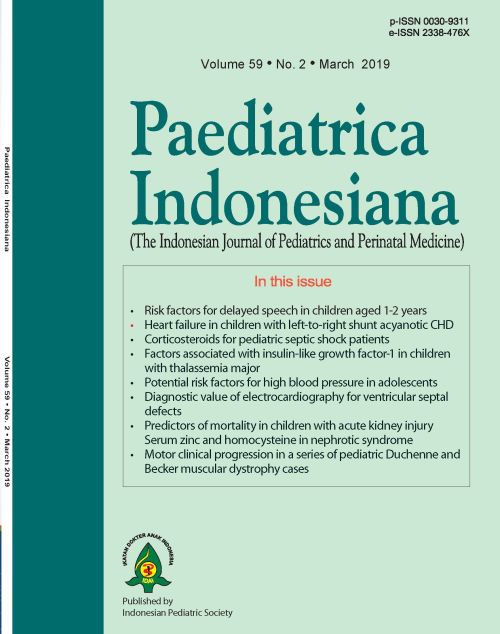Corticosteroids for pediatric septic shock patients
Abstract
Background Septic shock remains a major cause of mortality and admission to the pediatric intensive care unit (PICU) in children. Management includes adequate fluid resuscitation, followed by catecholamine infusion, if needed. Corticosteroid therapy is advised for catecholamine-refractory shock, although this practice is controversial, as it was not beneficial in other studies.
Objective To assess corticosteroid use in pediatric septic shock patients in Cipto Mangunkusumo Hospital.
Methods This cross-sectional study included all patients aged 1 month-18 years with a diagnosis of septic shock during the study period of January 2014 to July 2018 admitted in PICU Dr. Cipto Mangunkuskumo Hospital, Jakarta. Data obtained from medical records were, age, sex, immunology status, port d’entrée of sepsis, inotropic and vasopressor usage, mechanical ventilation, corticosteroid type, hospital length of stay (LOS), and mortality outcome.
Results Of 217 children with septic shock, 12 patients (5.5%) received corticosteroid therapy. The most common corticosteroid given was hydrocortisone (80%), with a 2 mg/kg BW loading dose, followed by a continuous infusion dose of 2-50 mg/kg BW/day. Almost all patients (11/12) received corticosteroid therapy until they died. Median duration of corticosteroid use was 2 (range 1-7) days, median number of inotropes and vasopressors used was 3 (range 2-4) agents, median LOS was 3 (range 1-9) days, and mortality rate was 100%.
Conclusion A small proportion of pediatric septic shock patients received corticosteroid therapy. Their mortality rate was 100%. Further clinical study is needed to evaluate the benefit of corticosteroid therapy in pediatric septic shock patients.
References
2. Jaramillo-Bustamante JC, Marín-Agudelo A, Fernández-Laverde M, Bareño-Silva J. Epidemiology of sepsis in pediatric intensive care units: first Colombian multicenter study. Pediatr Crit Care Med. 2012;13:501-8.
3. Bryce J, Boschi-Pinto C, Shibuya K, Black RE, WHO Child Health Epidemiology Reference Group. WHO estimates of the cause of death in children. Lancet. 2005;365:1147-52.
4. Saraswati DD, Pudjiadi AH, Djer MM, Supriyatno B, Syarif DR, Kurniati N. Faktor risiko yang berperan pada mortalitas sepsis. Sari Pediatri. 2014;15:281-8.
5. Rusmawatiningtyas D, Nurnaningsih. Mortality rates in pediatric septic shock. Paediatrica Indonesiana. 2016;56:304-10.
6. de Oliveira CF. Early goal-directed therapy in treatment of pediatric septic shock. Shock. 2010;34:44-7.
7. Pizarro CF, Troster EJ, Damiani D, Carcillo JA. Absoolute and relative adrenal insufficiency in children with septic shock. Crit Care Med. 2005;33:855-9.
8. Wong HR, Cvijanovich NZ, Allen GL, Thomas NJ, Freishtat RJ, Anas N, et al. Corticosteroids are associated with repression of adaptive immunity gene programs in pediatric septic shock. Am J Respir Crit Care Med. 2014;189:940-6.
9. Atkinson SJ, Cvijanovich NZ, Thomas NJ, Allen GL, Anas N, Bigham MT, et al. Corticosteroids and pediatric septic shock outcomes: a risk stratified analysis. PLoS ONE. 2014;9:112702.
10. Katsenos CS, Antonopoulou AN, Apostolidou EN, Ioakeimidou A, Kalpakou GT, Papanikolaou MN, et al. Early administration of hydrocortisone replacement after the advent of septic shock: impact on survival and immune response. Crit Care Med. 2014;42:1651-7.
11. Menon K, McNally DM, O’Hearn K, Acharya A, Wong HR, Lawson M, et al. A randomized controlled trial of corticosteroids in pediatric septic shock: a pilot feasibility study. Pediatr Cric Care Med. 2017;18:505-12.
12. Nichols B, Kubis S, Hewlett J, Yehya N, Srinivisan V. Hydrocortisone therapy in catecholamine-resistant pediatric septic shock: a pragmatic analysis of clinician practice and association with outcomes. Pediatr Crit Care Med. 2017;18:406-14.
13. Dellinger PR, Carlet JM, Masur H, Gerlach H, Calandra T, Cohen J, et al. Surviving Sepsis Campaign guidelines for management of severe sepsis and septic shock. Crit Care Med. 2004;32:859-73.
14. Casartelli CH, Garcia PC, Piva JP, Branco RG. Adrenal insufficiency in children with septic shock. J Pediatr (Rio J). 2003;79:169-76.
15. Zimmerman JJ, Williams MD. Adjunctive corticosteroid therapy in pediatric severe sepsis: observations from the RESOLVE study. Pediatr Crit Care Med. 2011;12:2-8.
16. Gibbison B, Lopez-Lopez JA, Higgins JP, Miller T, Angelini GD, Lightman SL, et al. Corticosteroids in septic shock: a systematic review and network meta-analysis. Crit Care. 2017;21:78.
17. Menon K, McNally D, Choong K, Sampson M. A systematic review and meta-analysis on the effect of steroids in pediatric shock. Pediatr Crit Care Med. 2013;14:474–80.
18. Menon K, McNally JD, Choong K, Ward RE, Lawson ML, Ramsay T, et al. A survey of stated physician practices and beliefs on the use of steroids in pediatric fluid and/or vasoactive infusion-dependent shock. Pediatr Crit Care Med. 2013;14:462–6.
19. Davis AL, Carcillo JA, Aneja RK, Deymann AJ, Lin JC, Nguyen TC, et al. American College of Critical Care Medicine clinical practice parameters for hemodynamic support of pediatric and neonatal septic shock. Crit Care Med. 2017;45:1061-93.
20. Popli V, Kumar A. Validation of PRISM III ( Pediatric Risk of Mortality) scoring system in predicting risk of mortality in a pediatric intensive care unit. IOSR Journal. 2018;17: 81-7.
21. Metta D, Soebardja D, Hudaya D. The Use of Pediatric Logistic Organ Dysfunction (PELOD) scoring system to determine the prognosis of patients in pediatric intensive care units. Peadiatrica Indonesiana. 2006; 46: 1-6.
Copyright (c) 2019 Irene Yuniar, Vembricha Nindya Manusita, Sonya Leonardy Low

This work is licensed under a Creative Commons Attribution-NonCommercial-ShareAlike 4.0 International License.
Authors who publish with this journal agree to the following terms:
Authors retain copyright and grant the journal right of first publication with the work simultaneously licensed under a Creative Commons Attribution License that allows others to share the work with an acknowledgement of the work's authorship and initial publication in this journal.
Authors are able to enter into separate, additional contractual arrangements for the non-exclusive distribution of the journal's published version of the work (e.g., post it to an institutional repository or publish it in a book), with an acknowledgement of its initial publication in this journal.
Accepted 2019-02-25
Published 2019-02-25













